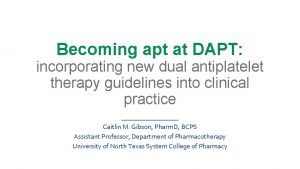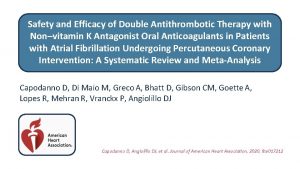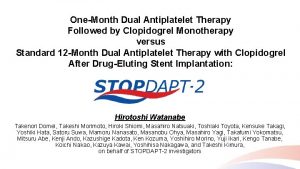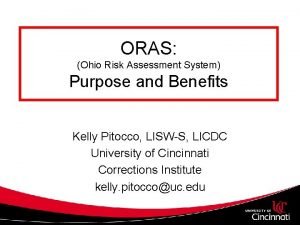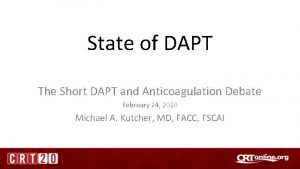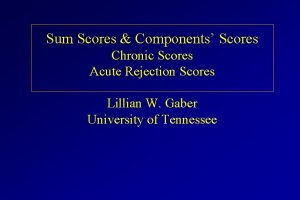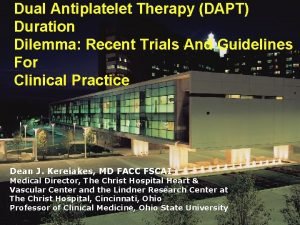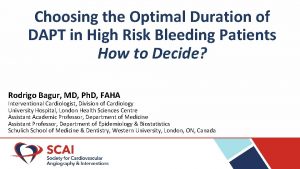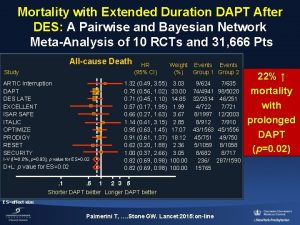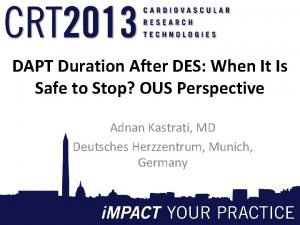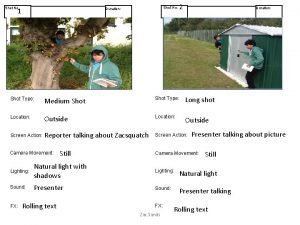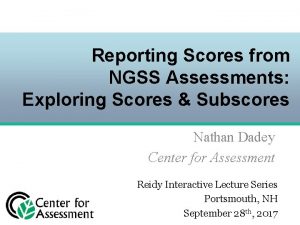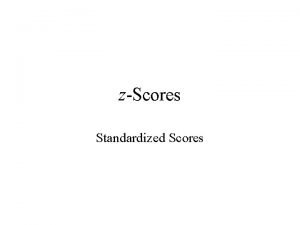Risk Scores to Guide DAPT Duration David J






















- Slides: 22

Risk Scores to Guide DAPT Duration David J. Cohen, M. D. , M. Sc. Director, Cardiovascular Research Saint-Luke’s Mid America Heart Institute Professor of Medicine University of Missouri-Kansas City CRT 2019 - 9 mins

Disclosures Grant Support/Drugs – Daiichi-Sankyo Grant Support/Devices – – Edwards Lifesciences Medtronic CSI V-Wave Medical - Abbott Vascular - Boston Scientific - Corvia Consulting/Advisory Boards – – Medtronic Janssen Pharmaceuticals - Edwards Lifesciences - Heartflow DJC: 2/19

History of DAPT after PCI/Stenting 1990 2000 1994 BMS approved No DAPT 2010 2003 SIRIUS, TAXUS 4 3 -6 months 1998 ISAR, STARS 1 month 2007 DES “Firestorm” 12+ months 2014 DAPT trial et al “Individualize”

DAPT Duration: How do we Decide? Palmerini T and Stone GW. EHJ 2016; 37: 353 -64

DAPT Bleeding and Ischemic Risk Scores • PARIS Scores (bleeding + ischemia) • DAPT Score (net benefit) • PRECISE DAPT Score (bleeding)

DAPT Bleeding and Ischemic Risk Scores • PARIS Scores (bleeding + ischemia) • DAPT Score (net benefit) • PRECISE DAPT Score (bleeding)

PARIS Ischemic Risk Score • Predicts composite of stent thrombosis or MI • Developed in 4, 190 pt all comer PCI registry, validated in the ADAPTDES registry – (C-stat=0. 65) Baber, Mehran, Guistino et al. JACC 2016.

PARIS: Gradient of Ischemic Risk By Score Low Risk (0 -2) Intermediate Risk (3 -4) High risk (≥ 5)

PARIS Bleeding Risk Score • Predicts BARC 3 or 5 bleed • Validated in ADAPT-DES (Cstat 0. 64)

Gradient of Bleeding Risk By Score Low Risk (0 -3) Intermediate Risk (4 -7) High risk (≥ 8)

PARIS Risk Scores: Summary • Can be used together to estimate ischemic and bleeding risks separately • Intuitive, plausible, easy to use, validated • Developed in all-comer population including patients on chronic anticoagulation highly generalizable • Key Limitation: PARIS bleeding and ischemic risk scores are correlated and share common variables – High risk bleeding patients are often also high ischemic risk

DAPT Bleeding and Ischemic Risk Scores • PARIS Scores (bleeding + ischemia) • DAPT Score (net benefit) • PRECISE DAPT Score (bleeding)

The DAPT Score Points Distribution of DAPT Scores among all randomized subjects in the DAPT Study 30% -2 -1 0 1 Current Smoker 1 Prior PCI or Prior MI CHF or LVEF < 30% Index Procedure Characteristic MI at Presentation Vein Graft PCI Stent Diameter < 3 mm 1 2 Percentage of Patients Variable Patient Characteristic Age ≥ 75 65 - 74 < 65 Diabetes Mellitus 25% 20% 15% 10% 5% 0% 1 2 1 -2 -1 0 1 2 3 4 5 6 7 8 9 10 DAPT Score 17

Continued Thienopyridine vs. Placebo Treatment Effect by DAPT Score Quartile (N = 11, 648) Q 1 = DAPT Score -2 to 0 Q 3 = DAPT Score 2 Q 2 = DAPT Score 1 Q 4 = DAPT Score > 2 Risk Difference (Continued Thienopyridine – Placebo), 12 -30 M 4. 0% 3. 0% Stent Thrombosis Q 1 Q 2 Q 3 Q 4 Myocardial Infarction Q 1 Q 2 Q 3 Q 4 GUSTO Moderate/ Severe Bleeding Q 1 Q 2 Q 3 Q 4 1. 97% 2. 0% 1. 17% 1. 0% 0. 69% 0. 03% -0. 07% -0. 06% -0. 73%-0. 59% -1. 0% -2. 0% -1. 34% -2. 18% -3. 0% -4. 0% -2. 56% -3. 48% 18

Risk Difference (Continued Thienopyridine – Placebo), 12 -30 M Continued Thienopyridine vs. Placebo Treatment Effect by DAPT Score Quartile (N = 11, 648) Mortality 4. 0% Net Adverse Events 3. 0% Q 1 Q 2 Q 3 Q 4 2. 0% 1. 0% Q 1 Q 2 Q 3 Q 4 1. 53% 0. 99% 0. 49% 0. 0% 0. 37% 0. 09% -0. 06% -1. 0% -2. 0% -1. 99% -3. 0% -4. 0% -3. 43% DAPT Score <2 DAPT Score ≥ 2 DAPT Score <2 19 DAPT Score ≥ 2 19 19

DAPT Score: Summary • Intuitive, plausible, validated, easy to use • Only score to simultaneously stratify bleeding and ischemic risk to identify high ischemic risk/low bleed risk patients (long DAPT) and low ischemic risk/high bleed risk patients (short DAPT) • Key Limitations: – Excludes certain patient types for whom risk prediction may be desirable (e. g. , pts on OAC or with prior h/o bleeding) – Only predicts benefit of extending DAPT from 12 to 30 months does not provide insight about shortening DAPT

DAPT Bleeding and Ischemic Risk Scores • PARIS Scores (bleeding + ischemia) • DAPT Score (net benefit) • PRECISE DAPT Score (bleeding)

PRECISE-DAPT Risk Score • Risk score to predict 1 -year major bleeding on DAPT • Developed using pooled data from 8 multicenter RCTs of varying DAPT duration • Bleeding endpoint = TIMI major or minor bleeding between 7 days and 1 year after PCI • Score based on patient characteristics available at time of index PCI procedure Costa F, et al. Lancet 2017; 389: 1025 -34

PRECISE Risk Score • Score (range 0 -100) includes 5 independent risk factors – – – Hemoglobin Age Prior bleeding -- WBC -- Cr. Cl • Top quartile (score >25) correlates with high risk of bleeding (2 -4%/year) • Available as web-based calculator (http: //www. precisedaptscore. com/predapt/ webcalculator. html) and phone app Costa F, et al. Lancet 2017; 389: 1025 -34

PRECISE Risk Score: Net Clinical Benefit • Net benefit of long DAPT positive in first 3 quartiles and only harmful in top quartile Risk Net Clinical Quartile Benefit 1 + 1. 4% 2 + 0. 8% 3 + 2. 0% 4 - 1. 2% Costa F, et al. Lancet 2017; 389: 1025 -34

Conclusions • The PARIS, PRECISE DAPT, and DAPT Scores are each useful to help make decisions regarding optimal dual antiplatelet therapy duration among PCI patients • The score one uses will depend on the patient profile and timing of decision, as well as the needs and specific tastes of individual clinicians • Using these tools in combination with clinical judgment is the most evidence-based method for determining optimal DAPT duration, and can support patient shared-decision making

 Typologies are typically nominal composite measures.
Typologies are typically nominal composite measures. Lydia glaw
Lydia glaw Sihd medical abbreviation
Sihd medical abbreviation Dapt
Dapt Dapt
Dapt Market risk assessment
Market risk assessment Oras risk assessment
Oras risk assessment Risk projection in software engineering
Risk projection in software engineering Risk avoidance insurance
Risk avoidance insurance Absolute risk vs relative risk
Absolute risk vs relative risk Residual risk and secondary risk pmp
Residual risk and secondary risk pmp Inherent risk vs control risk
Inherent risk vs control risk Absolute risk vs relative risk
Absolute risk vs relative risk Activity sheet 1: conservative, moderate or speculative?
Activity sheet 1: conservative, moderate or speculative? Risk classification
Risk classification Risk financing retention adalah
Risk financing retention adalah The biggest risk is not taking any risks
The biggest risk is not taking any risks Fiduciary investment risk management association
Fiduciary investment risk management association Ir x cr x dr
Ir x cr x dr Business risk and financial risk leverage
Business risk and financial risk leverage Attributable risk
Attributable risk Risk map risk management
Risk map risk management Relative risk calculation
Relative risk calculation


